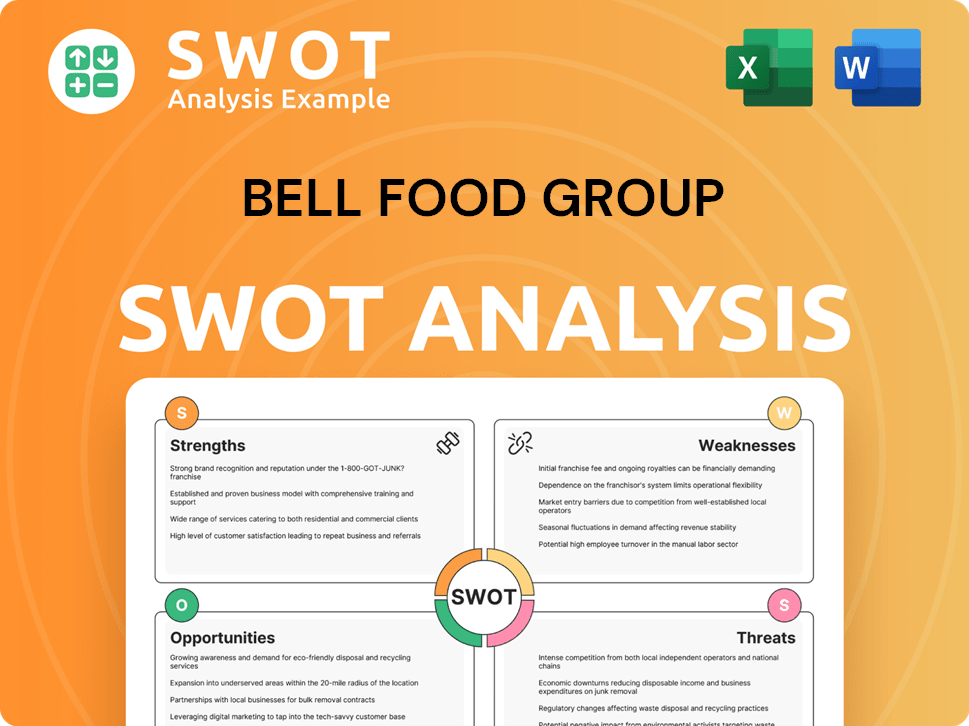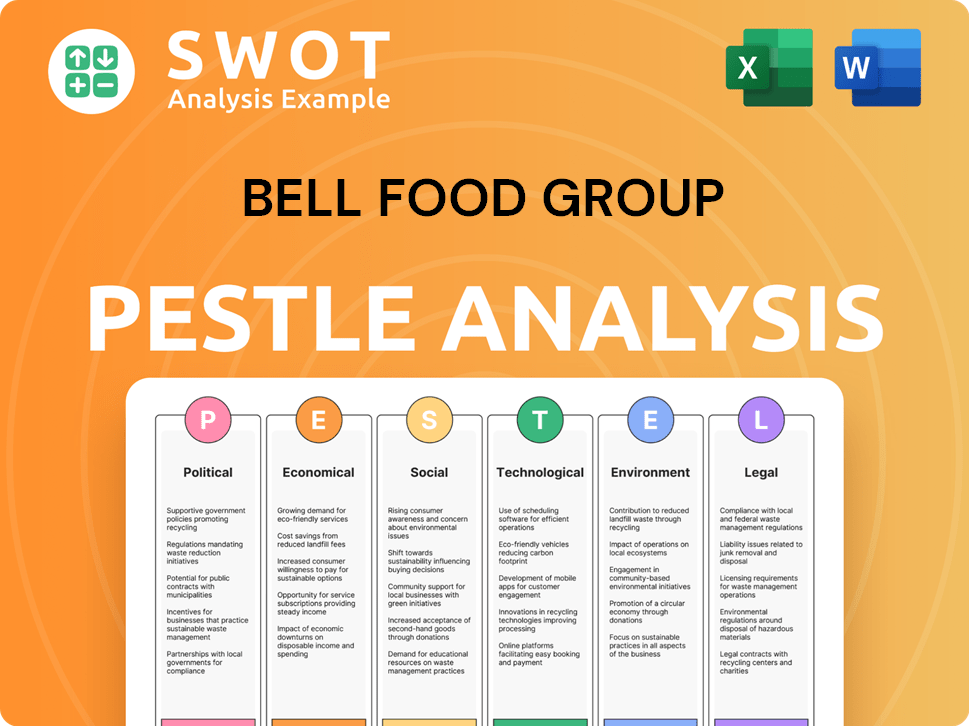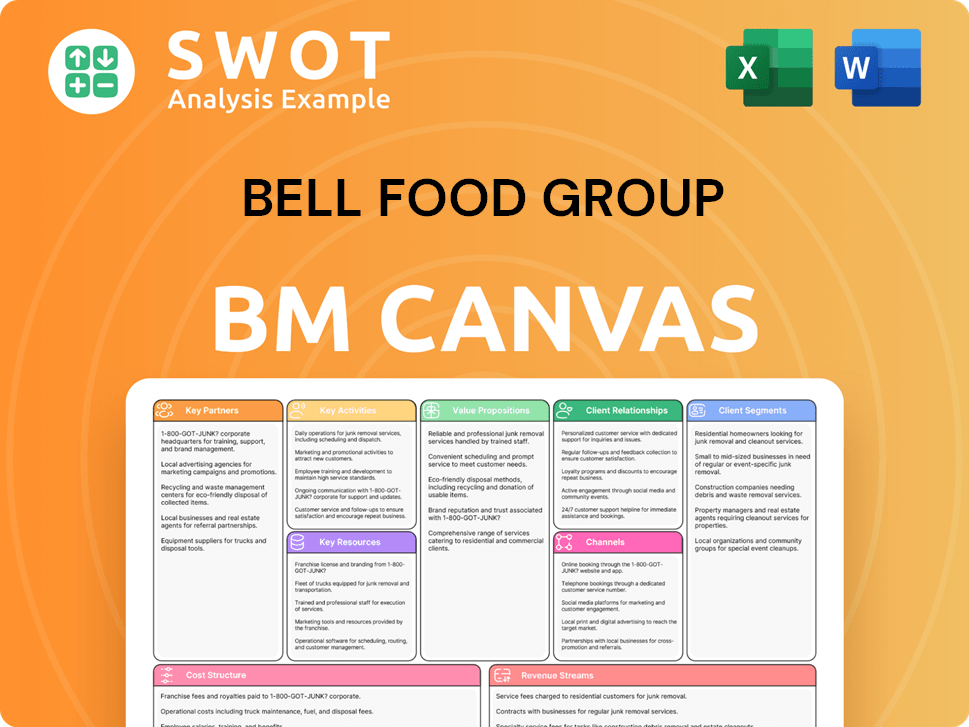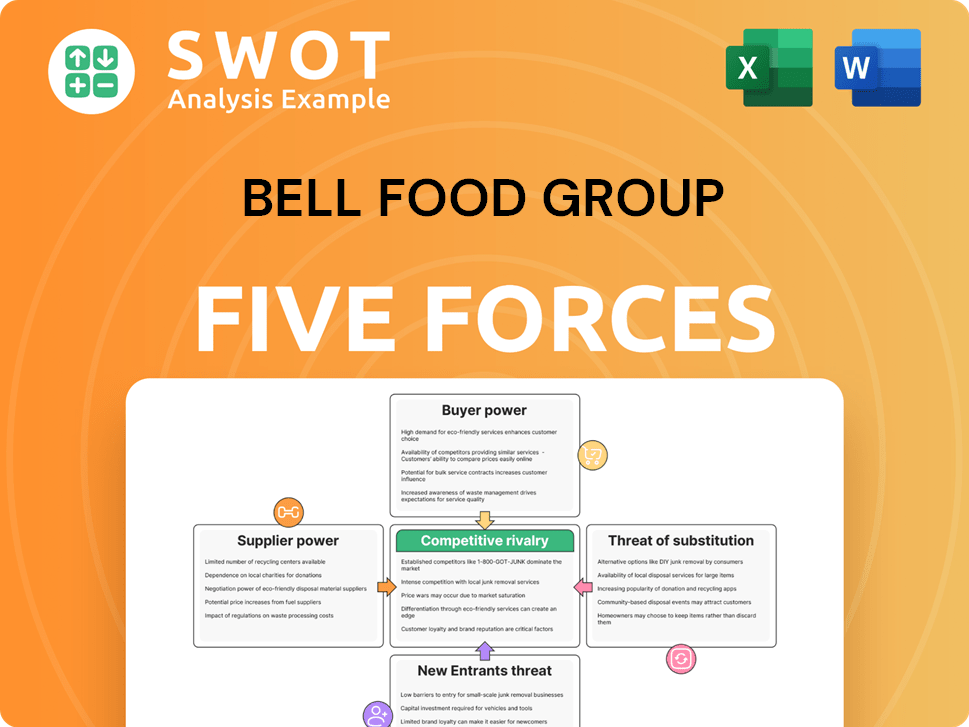Bell Food Group Bundle
How Does Bell Food Group Thrive in the European Food Market?
Bell Food Group, a powerhouse in the Swiss food industry, boasts impressive financial figures, including CHF 4.3 billion in sales in 2023. This success story is built on a foundation of strong brands like Bell and Hilcona, offering a diverse range of food products. Understanding the inner workings of Bell Food Company is key to grasping its market dominance and future potential.

Delving into the operations of Bell AG is essential for investors, industry analysts, and consumers alike. This analysis will explore the company's core business strategies, from meat processing to convenience food production, providing valuable insights into its financial performance and market position. For those seeking a deeper understanding of Bell Food Group's strategic landscape, consider exploring a detailed Bell Food Group SWOT Analysis.
What Are the Key Operations Driving Bell Food Group’s Success?
Bell Food Group, a key player in the Swiss food industry, operates through a vertically integrated model. This approach allows for comprehensive control over the production process, from sourcing raw materials to delivering finished products. Their focus is on high-quality meat processing and the production of a wide array of convenience foods, catering to diverse consumer needs.
The value proposition of Bell Food Company centers on providing convenience, quality, and variety. They achieve this by combining traditional meat craftsmanship with innovative convenience food production. This integrated approach, coupled with a strong emphasis on product innovation and brand development, allows them to differentiate themselves in a competitive market.
Bell AG offers a diverse range of products. These include fresh meat, poultry, charcuterie, and seafood under the Bell brand, alongside fresh convenience products from Eisberg. Hilcona specializes in fresh pasta and ready meals, while Hügli focuses on dry convenience products. These offerings cater to retail, wholesale, and food service sectors, both nationally and internationally.
The operational processes begin with sourcing raw materials, primarily meat, from trusted suppliers. This is followed by advanced processing, production, and packaging in state-of-the-art facilities across Europe. Stringent quality control and food safety standards are maintained throughout the supply chain.
The company offers convenience, quality, and variety to its customers. This is achieved through a combination of traditional meat processing and innovative convenience food production. This approach allows them to meet evolving consumer demands for healthy, quick, and easy meal solutions.
Logistics and distribution are critical components, ensuring timely delivery of fresh and perishable goods. Bell Food Group leverages partnerships with farmers and distributors to maintain a robust and efficient supply chain. The company's integrated approach allows for significant customer benefits, differentiating them in the market.
- Sourcing: Reliable suppliers ensure high-quality raw materials.
- Processing: Advanced facilities maintain high standards.
- Distribution: Extensive network for timely delivery.
- Innovation: Focus on product development to meet consumer needs.
Bell Food Group SWOT Analysis
- Complete SWOT Breakdown
- Fully Customizable
- Editable in Excel & Word
- Professional Formatting
- Investor-Ready Format

How Does Bell Food Group Make Money?
The primary revenue streams for Bell Food Group (also known as Bell AG) are derived from the sale of its extensive range of meat products and convenience foods. This includes fresh meat, poultry, charcuterie, seafood, and various convenience items like salads, sandwiches, and ready meals. The company's monetization strategy focuses on product sales, premium pricing, and leveraging its brand portfolio.
In 2023, the Meat business area, which includes brands like Bell and Hügli, generated sales of CHF 2.6 billion. The Convenience business area, encompassing Hilcona and Eisberg, achieved sales of CHF 1.7 billion during the same period. This demonstrates a balanced approach to revenue generation across different product segments.
Overall sales for the company reached CHF 4.3 billion in 2023, highlighting consistent performance. The company employs a combination of direct sales to retailers, wholesalers, and food service providers, along with indirect sales through distribution partners. They also adapt their offerings to regional preferences and market trends to ensure continued demand.
The monetization strategies of Bell Food Group are multifaceted, focusing on both volume and value. The company's approach includes direct and indirect sales channels, premium pricing for specialized products, and leveraging its strong brand portfolio. For more details on how the company has grown, you can read about the Growth Strategy of Bell Food Group.
- Product Sales: The core revenue driver, encompassing a wide variety of meat and convenience food products.
- Direct and Indirect Sales: Utilizing both direct sales to major retailers and wholesalers, and indirect sales through distribution partners.
- Premium Pricing: Charging higher prices for specialized or high-quality products to increase profitability.
- Brand Leveraging: Utilizing its established brand portfolio to drive sales volume and customer loyalty.
- Market Adaptation: Adapting product offerings to regional preferences and market trends.
Bell Food Group PESTLE Analysis
- Covers All 6 PESTLE Categories
- No Research Needed – Save Hours of Work
- Built by Experts, Trusted by Consultants
- Instant Download, Ready to Use
- 100% Editable, Fully Customizable

Which Strategic Decisions Have Shaped Bell Food Group’s Business Model?
The evolution of the company, including its strategic moves and competitive advantages, has been marked by significant milestones. A key aspect of its strategy has been continuous investment in production facilities and logistics, ensuring high efficiency and product quality. Strategic acquisitions have also played a crucial role in expanding its product portfolio and market reach. The integration of brands like Hilcona, Eisberg, and Hügli has broadened its convenience food offerings, diversifying its revenue streams beyond traditional meat processing.
Operational challenges, such as fluctuating raw material prices and evolving consumer preferences towards plant-based diets, have prompted the company to adapt. The company has responded by expanding its range of vegetarian and vegan products, particularly through its Hilcona and Eisberg brands, demonstrating agility in addressing market shifts. Its competitive advantages stem from strong brand recognition, economies of scale, and a focus on quality and innovation.
The company's ability to offer a comprehensive range of both traditional meat products and modern convenience foods provides a unique market position. Bell Food Group continues to adapt to new trends by investing in sustainable practices and exploring new product categories, ensuring its long-term relevance and sustained competitive edge in the dynamic food industry. For more information on the ownership structure, you can refer to the ownership details of Bell Food Group.
The company has consistently invested in modernizing its operations, contributing to its competitive edge. Strategic acquisitions, such as Hilcona, Eisberg, and Hügli, have expanded its product portfolio. These moves have diversified revenue streams beyond traditional meat processing, positioning the company for broader market opportunities.
The company has adapted to changing consumer preferences by expanding its vegetarian and vegan product lines. This includes offerings from brands like Hilcona and Eisberg. The focus on sustainability and exploration of new product categories ensures long-term relevance within the evolving food industry.
The company benefits from strong brand recognition across its core brands. Significant economies of scale, due to large-scale production and distribution networks, contribute to its competitive advantage. A relentless focus on quality and innovation further strengthens its market position.
The company has shown agility in addressing market shifts, particularly in response to the growing demand for plant-based products. Continuous investment in sustainable practices and exploration of new product categories ensures its long-term relevance. This adaptability supports its sustained competitive edge in the dynamic food industry.
In recent financial reports, the company has demonstrated consistent performance, with revenue streams diversified across various product categories. The company's focus on efficiency and innovation has allowed it to maintain a strong market position within the Swiss food industry.
- The company's investments in production and logistics have improved operational efficiency.
- Strategic acquisitions have expanded the product portfolio and market reach.
- The company has successfully adapted to changing consumer preferences by expanding its vegetarian and vegan product lines.
- Strong brand recognition and economies of scale contribute to its competitive advantage.
Bell Food Group Business Model Canvas
- Complete 9-Block Business Model Canvas
- Effortlessly Communicate Your Business Strategy
- Investor-Ready BMC Format
- 100% Editable and Customizable
- Clear and Structured Layout

How Is Bell Food Group Positioning Itself for Continued Success?
The Bell Food Group holds a prominent position in the European meat processing and convenience food sectors. As a leading player, the company commands a significant market share across Switzerland and other European countries, particularly in meat processing and ready-to-eat meals. Its diverse portfolio of brands, including Bell, Hilcona, Eisberg, and Hügli, supports strong customer loyalty and broad market penetration in both retail and foodservice channels.
However, Bell Food Company faces several challenges. These include fluctuations in raw material prices, especially for meat, which can affect profitability. Regulatory changes concerning food safety, animal welfare, and environmental standards also present potential hurdles, requiring ongoing adaptation and investment. Shifting consumer preferences, such as the growing demand for plant-based alternatives, could impact traditional meat sales, although the company has proactively addressed this by expanding its convenience food and vegetarian offerings. Intense competition from both large international food corporations and agile local producers adds further pressure.
Bell Food Group is a leading player in the Swiss food industry and across Europe, with a strong presence in meat processing and convenience foods. It holds significant market share, particularly in Switzerland, and benefits from a diverse brand portfolio. This includes brands like Bell, Hilcona, Eisberg, and Hügli, which contribute to its market penetration.
The company faces risks such as volatile raw material prices, especially for meat, which impacts profitability. Regulatory changes regarding food safety and environmental standards pose challenges. Shifting consumer preferences towards plant-based alternatives could affect traditional meat sales. Intense competition from both international and local producers also presents an ongoing challenge.
Bell Food Group is focused on strategic initiatives to sustain and expand its profitability. This includes continued investment in product innovation, especially in the convenience and plant-based segments, to meet evolving consumer demands. The company is also focused on optimizing its operational efficiency and supply chain management. Expansion where strategic opportunities arise.
The company is investing in product innovation, particularly in convenience and plant-based segments to cater to evolving consumer demands. They aim to optimize operational efficiency and supply chain management to mitigate cost pressures. Leadership emphasizes sustainable practices and further international expansion where strategic opportunities arise.
Bell Food Group is concentrating on several strategic initiatives to bolster its market position and ensure future growth. These strategies are designed to address current challenges and capitalize on emerging opportunities within the Swiss food industry and beyond. The company is actively adapting to shifting consumer preferences and market dynamics.
- Product Innovation: Continuous investment in new product development, particularly in convenience foods and plant-based alternatives, to meet evolving consumer demands. This includes expanding the range of vegetarian and vegan options.
- Operational Efficiency: Optimizing operational processes and supply chain management to reduce costs and improve profitability. This involves streamlining production processes and enhancing logistics.
- Sustainable Practices: Commitment to sustainable practices across all operations. This includes reducing environmental impact, promoting animal welfare, and sourcing ingredients responsibly.
- International Expansion: Identifying and pursuing strategic international expansion opportunities to increase market share and diversify revenue streams. This may involve acquisitions or partnerships.
Bell Food Group Porter's Five Forces Analysis
- Covers All 5 Competitive Forces in Detail
- Structured for Consultants, Students, and Founders
- 100% Editable in Microsoft Word & Excel
- Instant Digital Download – Use Immediately
- Compatible with Mac & PC – Fully Unlocked

Related Blogs
- What are Mission Vision & Core Values of Bell Food Group Company?
- What is Competitive Landscape of Bell Food Group Company?
- What is Growth Strategy and Future Prospects of Bell Food Group Company?
- What is Sales and Marketing Strategy of Bell Food Group Company?
- What is Brief History of Bell Food Group Company?
- Who Owns Bell Food Group Company?
- What is Customer Demographics and Target Market of Bell Food Group Company?
Disclaimer
All information, articles, and product details provided on this website are for general informational and educational purposes only. We do not claim any ownership over, nor do we intend to infringe upon, any trademarks, copyrights, logos, brand names, or other intellectual property mentioned or depicted on this site. Such intellectual property remains the property of its respective owners, and any references here are made solely for identification or informational purposes, without implying any affiliation, endorsement, or partnership.
We make no representations or warranties, express or implied, regarding the accuracy, completeness, or suitability of any content or products presented. Nothing on this website should be construed as legal, tax, investment, financial, medical, or other professional advice. In addition, no part of this site—including articles or product references—constitutes a solicitation, recommendation, endorsement, advertisement, or offer to buy or sell any securities, franchises, or other financial instruments, particularly in jurisdictions where such activity would be unlawful.
All content is of a general nature and may not address the specific circumstances of any individual or entity. It is not a substitute for professional advice or services. Any actions you take based on the information provided here are strictly at your own risk. You accept full responsibility for any decisions or outcomes arising from your use of this website and agree to release us from any liability in connection with your use of, or reliance upon, the content or products found herein.